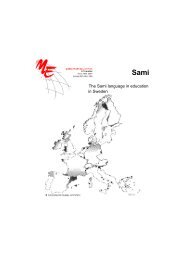Multilingual Early Language Transmission (MELT) - Mercator ...
Multilingual Early Language Transmission (MELT) - Mercator ...
Multilingual Early Language Transmission (MELT) - Mercator ...
Create successful ePaper yourself
Turn your PDF publications into a flip-book with our unique Google optimized e-Paper software.
Child-staff ratios and maximum group size<br />
The ratio is 1 practitioner for every 4 children under age 3 years; 1 trained adult at every day<br />
care is needed. For every 7 children over 3 years 1 trained adult is needed. In family day<br />
care, the ratio per day care parent is 4, plus one half day pre-school or school child including<br />
day care parents’ own (under school age) children. 39<br />
In pre-school education, for 6 years-olds, the maximum ratio is 1 teacher (with an assistant)<br />
for 13 children, with the recommendation for the maximum group size of 20 children<br />
When arranging part-time service the ratio for 3-6-year-olds is one to thirteen and for<br />
children under three the ratio is the same as in full-time service. These ratios apply also to<br />
pre-school education when provided in day care centres. In family day care, the maximum<br />
group is 4 full-day children, plus 1 half day child. In child care centres, there are no group size<br />
requirements. The adult-child ratio in day care centres is one to seven for 3-6-year-olds and<br />
one to four for children under the age of three in full-time service.<br />
2.3.3 Training of practitioners<br />
All teacher education is Swedish had until 2006 been part of Åbo Academy University. Due to<br />
a change in law in 2006 other bilingual universities can now share the responsibility for<br />
educating teachers in Swedish. A new early childhood teacher education program in Swedish<br />
at the University of Helsinki started in September 2011. There was a great need for this<br />
program to be located in southern Finland. (See Gunilla Holm, chapter9).<br />
The day care institutions are led by a pre-school teacher who is required to have at least a<br />
secondary-level degree, a university bachelor degree, mostly in the field of ‘social welfare<br />
and health care’ or ‘social sciences with an additional pedagogical course.’ When group size<br />
exceeds 13, the teacher in pre-school must have an assistant with at least an upper<br />
secondary level training.<br />
One in three of the staff must have a post-secondary level degree (Bachelor of Education,<br />
Master of Education or Bachelor of Social Sciences). Mostly the different institutions, led by<br />
preschool teachers, are supported by other kinds of caring staff.<br />
The pre-school teacher in the Swedish pre-school is commonly a native speaker of Swedish,<br />
usually the pre-school teachers speaks fluent Finnish.<br />
2.3.4 Pedagogical guidelines and Folkhälsan<br />
The aim of pre-school education is to improve children´s capacity of learning; in fact children<br />
are taught new facts and new skills through play. The national curriculum guidelines on <strong>Early</strong><br />
39 Starting Strong II: <strong>Early</strong> Childhood Education and Care (2006) http://www.oecd.org/dataoecd/16/2/37423404.pdf [Accessed June 2011].<br />
29



